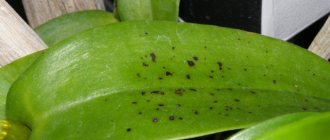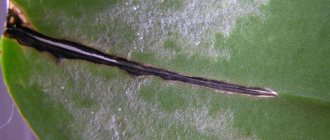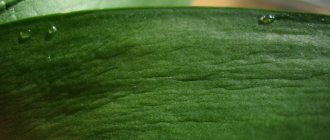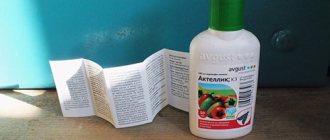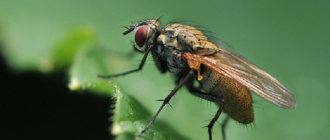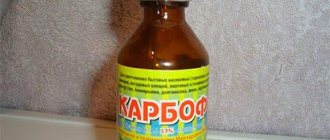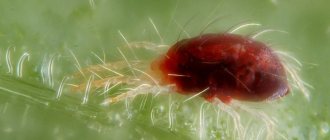Who are worms?
The scale insect is a pest that feeds on plant sap and is a relative of scale insects. Insects are covered with a protective waxy coating and villi (clearly visible in the photo), which makes it difficult to control them.
Body length ranges from 3 to 12 mm, depending on the species. Males are much smaller than females, have wings, and resemble small white midges. Due to the lack of oral apparatus, they do not need food, and their lifespan is not long.
Females usually live in colonies, on different parts of the plant; They are characterized by an asexual method of reproduction - parthenogenesis.
Meet the mealybug
These insects belong to the suborder Coccidae, which includes representatives from several families:
- Lamellar
- Gigantic
- Voylochnikov
- Paraglandular.
All representatives of this species are close relatives of the scale insect, a pest well known to people involved in floriculture. In addition to its scientific name, the mealybug also received another name, invented by plant growers and perfectly describing the essence of the pest. People gave them the name hairy lice because their larvae and females suck the juices from young shoots, causing them to dry out.
Types of representatives and structural features
Externally, the mealybug resembles a scale insect, but unlike it, it is white in color. This insect has great mobility, and at any age. The pest's elongated oval body is covered with a white coating, with waxy plates along the edges. Depending on the species, an individual can reach a length of up to 12 mm. The male and female forms have significant differences in physiological characteristics.
So, the first are endowed with:
- Wings
- Normally developed limbs
- Abdomen with two caudal filaments
- Lack of a mouth.
Adult males do not feed. Females, unlike males, have sucking mouthparts, although some of the varieties may lack legs. Most mealybugs are viviparous and very fertile.
Eggs are laid in a special cotton wool-shaped facial sac. The larvae hatching from them are very mobile. And already at the first stage of development they actively move throughout the plant. Having sucked, they temporarily lose mobility and gain it again after molting, when they begin to look for new feeding places. Oviposition in most forms occurs in secluded places.
The modern fauna includes more than 1,600 species of this pest. Among them there are parasites on the following representatives of the fauna:
- Fruit
- Decorative
- Greenhouse
- Technical.
The most famous and widespread almost everywhere are such representatives as:
- Lamellar
- Grooved (parasitic on citrus)
- Seaside
- Grape
- Comstock (living on mulberries).
Among them there are also those that people have learned to use in their activities, for example, lacquer and cochineal, from which carmine (a red dye) is obtained. However, humans are constantly fighting against mealybug species that live on indoor plants. Let's look at the most common of them.
Bristly
The appearance of this pest is difficult to miss. It has a dense coat with a longer last pair of ventral setae. The female finds a secluded place on the food plant in which she lays several eggs. The larvae emerge from them quite quickly.
Seaside
Females are covered with a whitish waxy coating and have 17 pairs of elongated filaments along the edges of the body. Their length reaches 5mm. Adult insects can be seen in the axils of the leaves, where they lay eggs. Moreover, the females of this species are among the most fertile and are capable of laying up to 400 eggs. In apartment conditions, up to 5 generations of the pest develop per year.
Grape mealybug
Insects of this species attack subtropical crops and are usually found in southern regions. Its females are yellow-brown in color and covered with a white coating. They usually overwinter in cracks in the bark and wake up when temperatures reach positive temperatures.
They reproduce parthenogenetically, since males are very rare in nature. Females lay eggs in the bark of shoots. In apartment conditions, they parasitize cacti, succulents and some types of orchids.
How do worms harm plants?
Insects cause great harm, leading pets to death. They prefer plants with large leaves, such as palm trees, ficus, orchids, laurel, and ferns. They settle on the reverse side of the leaf, in the area of large veins and stems.
- Mealybugs on indoor flowers suck out the juice, weakening them. Some species attack the roots.
- During their life, they secrete a sweet, sticky secretion that attracts ants and also contributes to sooty fungus and mold.
- Saliva contains phytotoxic enzymes that cause plant poisoning.
What the mealybug is afraid of - folk methods of control
If a mealybug is detected in time, there will be no difficulties in dealing with this parasite on indoor plants using chemicals and folk remedies. A popular killer mixture for mealybugs from the arsenal of folk craftsmen is green soap, and this product is prepared from an alcohol tincture of calendula with the addition of laundry soap shavings. This product can be replaced with ordinary liquid soap, which is used to wipe the leaves of plants at intervals of 3-5 days.
fight against mealybugs - in the photo
An olive oil emulsion works well against small scale scale colonies - it is prepared from a liter of water and a couple of tablespoons of oil, vigorously shaking the mixture, and when the liquid becomes cloudy, it is sprayed onto the plant, paying special attention to the places where scale insects feed. The oil creates an impenetrable film on the surface of their body; the parasites cannot breathe and die.
Soap solutions and emulsions are not suitable for indoor plants with fuzzy leaves, but they are good when mealybugs have settled on a cactus, streptocarpus or other crops with smooth leaf blades. If a harmful worm is found on violets, gloxinias and similar plants, you should use other means:
- Infusion of shag;
- Decoction of cyclamen rhizomes;
- Alcohol tincture from horsetail;
- Water infusion of garlic.
These products can be applied using a sprayer, but in some cases you will have to additionally treat the plants with cotton swabs soaked in them.
When a pest such as a mealybug appears, traditional methods of control should be used for several months in a row, and not only affected plants should be treated, but also healthy ones. Regular sanitary treatment of indoor plants will help to effectively combat the pest - the gardener will have to wash the green pets weekly with soapy water, trim and carefully burn the leaves on which colonies of parasites are found.
Developmental cycle of mealybugs
- Egg. Females lay eggs in a felt cocoon. Some species are viviparous - producing live larvae.
- The larvae move quickly, conquering new spaces; they are called “vagrants”. In some species, they are inactive. There is no gender distribution.
- Imago. After molting, strays become adults, females and males.
What do mealybugs look like?
Mealybugs, or, as they are popularly called, hairy lice , are sucking insects that are clearly visible to the naked eye. They got their name from the white cotton wool-like waxy secretions. Larvae and adult females suck young shoots, leaves, and buds. They greatly retard plant growth. The common citrus mealybug also attacks the root system.
Insects are very mobile and move well at almost any age, covered with a white powdery waxy coating, often with waxy plates along the edge. Dimensions 3-6 (0.5-12) mm, depending on the type.
Sexual dimorphism is pronounced (when individuals of the same species have two forms that differ in physiological characteristics). Males have wings (usually the first pair), normally developed limbs, and an abdomen with two tail filaments. There is no mouthparts (males do not feed as adults).
In a number of species, legs are reduced or absent. The oral apparatus is sucking. Most insects lay eggs; in some species, females are viviparous. The eggs are laid in a white cotton wool-like facial sac. Fertility is very high; many forms give 2, sometimes up to 4 generations per year.
Larvae of the 1st instar (vagrants) actively move along the food plant and can be carried by the wind. Having attached themselves to the plant, the larvae lose mobility; After molting, the larvae of the next instar again look for places to feed. Adult females of some species can actively crawl along the food plant. Before oviposition, many forms leave the feeding area and go into shelter.
There are over 1,600 species of scale insects in the world fauna; they are distributed everywhere, but mainly in the tropics. Among the scale insects there are many pests of fruit, industrial, ornamental crops and greenhouse plants. The most famous are the greenhouse lamellar bug, the Australian grooved bug (a pest of citrus fruits, a quarantine object), the bamboo bug, the citrus bug, the seaside bug, the grape bug, the Comstock bug (a mulberry pest), and the olive pollinia.
Some species of scale insects secrete useful substances used in the paint and varnish industry (varnish scale bug and cochineal, which produces red paint - carmine).
Mealybug. © Edson Momm
Mealybugs are easily recognized by their white cotton wool-like waxy coating; as a rule, they are clearly visible to the naked eye. Sugary discharge (honeydew) and a sooty fungus settling on it are the following symptoms of damage.
Signs of insect damage to indoor plants
At the initial stage of the disease, insects are difficult to detect, as they hide in the axils of the leaves.
Felt coating
A white coating appears on the stems and leaves of flowers, resembling cotton wool sprinkled with flour. These are cobwebs and wax dust secreted by females.
Sticky leaves
In the process of life, a sweet secret is released - honeydew, which is attractive to ants and moldy fungi. Leaves sticky marks on the pot, windowsill, window glass.
White lumps on roots
This sign can only be detected during transplantation. White lumps will be visible among the roots and soil. They can be confused with root aphids.
drooping look
A drooping appearance of the plant may be the only symptom of rootworm infestation.
How to deal with mealybugs
Treatment must be carried out comprehensively, using several methods. Good results are obtained with chemicals in combination with a mechanical method of removing insects.
Mechanical method
With this method, pests are removed by mechanical means:
- Cutting out severely affected leaves and branches.
- Wash off insects with soapy water, using a sponge or soft brush.
- Nearby surfaces should be thoroughly washed: window sills, shelves, window frames, flowerpots - they can be a source of microscopic larvae.
Chemical
Insecticides that have an intestinal and systemic mode of action are used against mealybugs. Due to the fact that insects are covered with a protective waxy coating, contact exposure has no effect.
Due to toxicity, it is advisable to use chemicals in cases of extreme necessity, if home remedies are problematic to use or do not help.
- "Aktara" has an intestinal-contact, systemic spectrum of action. It affects the pest by direct contact with it, with simultaneous penetration inside through the oral apparatus. When applied to the soil, it is well absorbed by the roots, making plant juices toxic to parasites.
- "Aktelik" has a wide spectrum of action, systemic and contact. Treatment is carried out by spraying.
- “Bi-58 new”, systemic-contact mode of action. Affects any stage of insect development. The substance is quickly absorbed by the plant, the death of pests occurs within 24 hours. Highly effective against insects that parasitize roots.
- “Golden Spark” – works systemically, has a long-lasting effect, up to 2 months.
Important: treatment with pesticides is carried out using personal protective equipment.
Biological insecticides
Biological preparations such as Fitoverm do not have a systemic effect, therefore they are not effective against scale insects.
Types of mealybug
Three types of pests are considered the most tenacious and difficult to exterminate. Each one is worth talking about in detail. If they appear in greenhouses or on indoor flowers, it is necessary to urgently treat industrial and greenhouse crops.
Bristly
The plaque on the body of such a worm forms small growths. Females in the shape of an elongated oval reach 3.5 mm. The body with three pairs of legs is orange or pinkish. Treatment of plants infected with insects is difficult due to the genetic characteristics of the species. Viviparous females live on the lower leaf blades, secluded places of the trunk.
Females quickly form colonies, inhibit plant development, and lead to its death. In bulbous crops, the roots are affected, eating away the central part of the bulb. Bristlebugs can be detected by drying leaves, drops of honeydew, and the development of sooty fungus - it forms dark brown or black spots of varying sizes.
Grape
The yellowish-brown or pinkish-cream body of the mealybug is wide, evenly covered with a powdery, waxy coating. Females are fertilized by males, there are few of them, they take off from the plant at any danger.
The larvae prefer to attach themselves along the prominent veins, which makes it easier to get to the nutrients. It forms clutches between unwinding young leaves. Small fibers in the form of cotton wool are noticeable on the shoots.
For massive population growth, humidity is needed no higher than 75%, temperature within +22...+25 °C. During treatment for mealybugs, it is advisable to move affected house plants to a cool place and isolate them from other plants.
Seaside
The most common type of mealybugs looks like a grain of rice flattened on the underside with jagged edges, three pairs of legs and lower hairy processes. For laying, females weave egg sacs and attach them:
- on the underside of the leaves;
- in bark cracks;
- at the base of the petiole;
- between the leaves of young shoots.
After the first molt, young females, already during the growth period, are able to lay up to 50 eggs. It takes up to a month for the mealybug to fully mature. In the clutch of an adult individual there are up to 600 pieces. The larvae quickly spread throughout the plant and, in loose soils, capture the root part.
During suction and molting they remain motionless. Honeydew is produced in large quantities - a favorite delicacy of small black ants. When these insects appear on fruit trees or in greenhouses, it is advisable to carry out preventive soap treatment of places where mealybugs can nest.
How to get rid of mealybugs without using chemicals
Chemicals are far from safe, especially when used in an apartment. Immediately after detecting a pest, you can use folk remedies.
Green soap
Environmentally friendly product. Soap foam is applied to open, visible areas. After 2 – 3 hours, after treatment, it should be washed off.
Tobacco infusion
- Shag, raw materials or tobacco dust, in the amount of 80 grams, pour 1 liter of warm water, leave for a day.
- Then the resulting infusion is filtered and brought to its original volume.
- Treatment is carried out by spraying or washing.
Prevention measures
Mealybugs are quite difficult to exterminate, severely depleting plants. Therefore, it is much more effective to prevent their occurrence.
- Compliance with the rules of care is the most important preventive measure, since pests, as a rule, attack weakened plants.
- Regular examination of “pets” will help to recognize infection at an early stage.
- Before you bring a new plant into your home, you need to inspect it carefully.
- Quarantine for newly acquired pets is at least 30 days.
- Soil disinfection.
- Thorough disinfection of pots after diseased flowers.
In order to fight a pest, you should know its preferences and biological characteristics. Eliminating conditions favorable for parasites is the main task of preventing infection.



